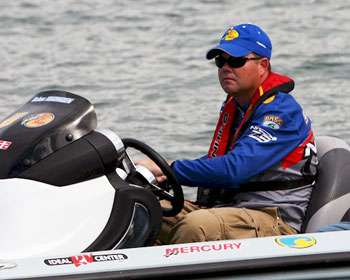
Whoever coined the phrase "money doesn't grow on trees" didn't know Elite Angler Brian Snowden. On his home waters of Table Rock Lake, Snowden has become a master at cashing checks by coaxing bass from deep water treetops. The Missouri pro offers some tips on how to take advantage of these bass magnets.
"The best deep tree is one that is located on the side or end of a long, flat gravel point, right before it drops off into the main river channel," he explains. When searching for individual treetops deep in the water column, Snowden admits that there's a whole lot more searching than finding — but the result is often worth the effort.
"The most productive areas only contain one or two trees because isolated trees tend to group the bass in a small area. On lakes like Table Rock, those few trees take a lot of time to find," he says.
While locating a single tree 80-feet deep on a massive body of water may be a challenge, Snowden is quick to point out that bluff ends are often areas where any bass angler can quickly locate productive deep wood. "You can often locate deep trees where the channel meets the end of a bluff," he explains. "Typically, the boat will be sitting in 35 to 110 feet of water, and the trees will rise anywhere from 30 to 60 feet off the bottom."
Using his depthfinder to scan the underwater terrain, Snowden tries to locate the densest treetop he can find. On his graph, a dense treetop will look just like the bottom, the trunk will appear as a red patch in the middle of his screen and individual branches jutting from the trunk will appear as small black lines. "You want to fish trees that are really dense, just like you would if you were flipping a tree you can see in shallow water," Snowden explains.
Because the best treetops are the densest, Snowden points out that it often impossible to distinguish fish on his graph unless they are holding above or on the sides of the treetop.
Once he has used his electronics to locate a suitable target, Snowden will then focus on targeting bass that are suspended in the tops.
"I'm basically presenting my bait directly over the top of the tree," he says. While it might be tempting to drop an offering deep into the heart of a tree, Snowden is quick to point out that in deep water the majority of bass will be located in the very top portion of the tree.
"I usually only let my bait drop into the first 2 to 3 feet of the treetop," he explains. "If the tree is sitting in less than 30 foot of water, that's the only time that I'll let my bait go all the way to the bottom."
Snowden's go-to offerings include a jigging spoon and drop shot rig, fished with a spinning reel on 8-pound-test line. With the drop shot, he opts for a 3/8- to 1/2-ounce weight in order to get the bait down to the tree top quickly. "Once my bait gets to the tree top, I'll shake it a little, hold it for 10 to 15 seconds, shake it again, hold it for another 10 to 15 seconds, and if I don't get a bite, then reel it in," explains Snowden.
Fishing deep treetops is a pattern that shines for Snowden throughout the summer months. "I think the bass pretty much stay around those treetops all summer because they live there, and because the shad will often be holding in the same areas," he explains. "Sometimes you only catch one good fish from each treetop, but there are times when I've pulled up and caught 10 to 12 keepers out of one tree. It just takes a little patience."




